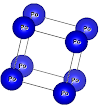To represent the optical properties, it is necessary to use a sampling as thin as possible in the Brillouin zone. To this end, the SCF calculation (potential of the convergence calculation) is performed for a very large number of points k.
The soubroutine "optic" then calculates, for each point k and each combination (occupied band / empty band), the components of the matrix dipole moment. The files created by this soubroutine are: TiC.symmat and TiC.mommat.
The calculation of the ε2 components on the Brillouin zone is effected by the soubroutine "joint". The file created by this soubroutine is: TiC.joint.
The application of the Kramers-Kronig formula to calculate ε1 components is performed by soubroutine "kram". It is at this level that we give the value of the "scisors operator" which is determined by the difference between the optical gap measured experimentally and theoretically optical gap. The files created by this soubroutine are: TiC.epsilon, TiC.sigmak, TiC.absorption, TiC.reflection, TiC.refraction, TiC.eloss.
It is also possible to add a Lorentzian enlargement reflects the experimental broadening. This allows to more easily compare the spectra obtained with the data EELS (Electron Energy Loss Spectroscopy).
It would be interesting to identify transitions which are responsible for the peaks in the curve of ε2. Generally, transitions in the optical response are caused by transitions of electrons between the valence band and the conduction band. These peaks in the linear optical spectra correspond to transitions in the band structure.
It is also possible to add a Lorentzian enlargement reflects the experimental broadening. This allows to more easily compare the spectra obtained with the data EELS (Electron Energy Loss Spectroscopy).
It would be interesting to identify transitions which are responsible for the peaks in the curve of ε2. Generally, transitions in the optical response are caused by transitions of electrons between the valence band and the conduction band. These peaks in the linear optical spectra correspond to transitions in the band structure.
Calculation of the components of the dielectric function
To calculate the components of the dielectric function using the graphical interface w2web, we procede as follows:- - We use a denser mesh which is for a metallic material of the order of 5000 (that's the equivalent of 165 special points in the irreducible Brillouin zone);
- - We perform SCF calculations to achieve the convergence of the potential;
- - We use another mesh denser than that of convergence which is about 20000 k using the subprogram "KGEN" from the "single programs" menu;
- - We calculate the eignen states and the eignen energies using the subprogram "LAPW1" from the "single programs" menu;
- - We select the task "OPTIC" from the "TASKS" menu, which contains the following operations:
- Calculate the Fermi potential with the sub-program "LAPW2";
- Edit the file TiC.inop as follows:
99999 1 number of k-points, first k-point
-5.0 2.2 Emin, Emax for matrix elements
1 number of choices (columns
in *outmat) - 0: MME into case.mme
1 Re xx
OFF ON/OFF writes MME to unit 4
- Calculate the matrix elements of the dipole moment with 'optic';
- Edit the file TiC.injoint as follows:
1 9999
9999 : LOWER,UPPER and (optional)
UPPER-VAL BANDINDEX
0.0000 0.00100
1.0000 : EMIN DE EMAX FOR ENERGYGRID IN ryd
eV
: output units
eV / ryd / cm-1
4 : SWITCH
1 :
NUMBER OF COLUMNS
0.1 0.1
0.3 :
BROADENING (FOR DRUDE MODEL - switch 6,7 - ONLY) - Calculate ε2 components with "joint";
- Edit the file TiC.inkram as follows:
0.1 Gamma: broadening of interband spectrum
0.0 energy shift (scissors operator)
0 add intraband contributions? yes/no: 1/0
12.60 plasma frequencies (from joint, opt 6)
It should be noted that for a metallic material, there is the intra-band contribution. If we want to consider this contribution in the calculation we must procede as following:
- Calculate the plasma energy with switch "6" instead of "4" and look for the value of the energy in the TiC.outputjoint file;
- Repeat the calculation ε2 components with the switch "4";
- Use this energy plasma in the TiC.kram file;
- Replace "0" to "1" in the third line of TiC.inkram file.

















11 Comments
Hello I'm a undergradute studente and I would like to kno in which book I could find all this concepts, everything I need to know in order to publish and use the program undertanding what I'm doing.
ReplyDeleteYou need to use many books
Deleteyou can use my memoir
Deletehttps://wien2k-algerien1970.blogspot.com/2014/11/voici-mon-memoire-de-magister-intitule.html
Thanks very much;
ReplyDeleteI need how i can deduce optical transmittance spectra from other optical datas.
Thank you in advance
Welcome
ReplyDeleteyou can use my memoir
https://wien2k-algerien1970.blogspot.com/2014/11/voici-mon-memoire-de-magister-intitule.html
can you please send me a video tutorial for this calculation?
Deletemy email id is : mail2buru@gmail.com
may I know how could I find the value of epsilon1 and epsilon2
Deletedans case.inop, 3eme ligne (number of choices)..est il toujours 1? ou dépend de la structure?..si c oui que dois je choisir pour une structure tetragonale? et merci
ReplyDelete1 parce qui'il y a une seule colonne Rex et s'il y a Rex, Rey on met 2
DeleteBonsoir
ReplyDeleteQuels types de fichiers WIEN2K devrais-je tracer pour obtenir les courbes de l'absorption ainsi que la partie imaginaire de la fonction diélectrique?
Merci
hi
ReplyDeleteI have an orthorhombic structure;so i put in tic.inop 3 as number of choices but in the output i had just Rxx and Ryy?